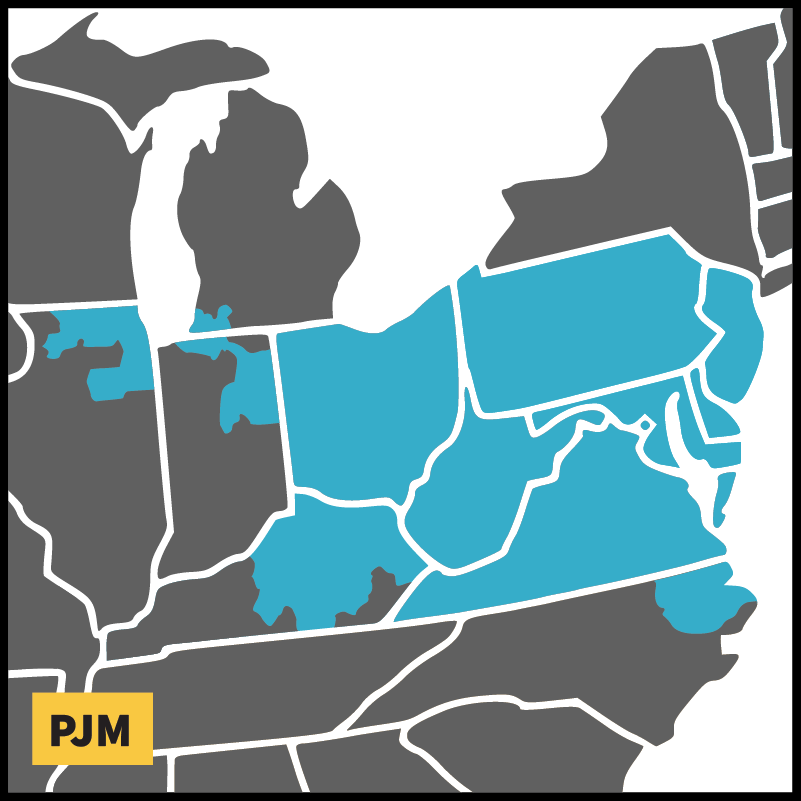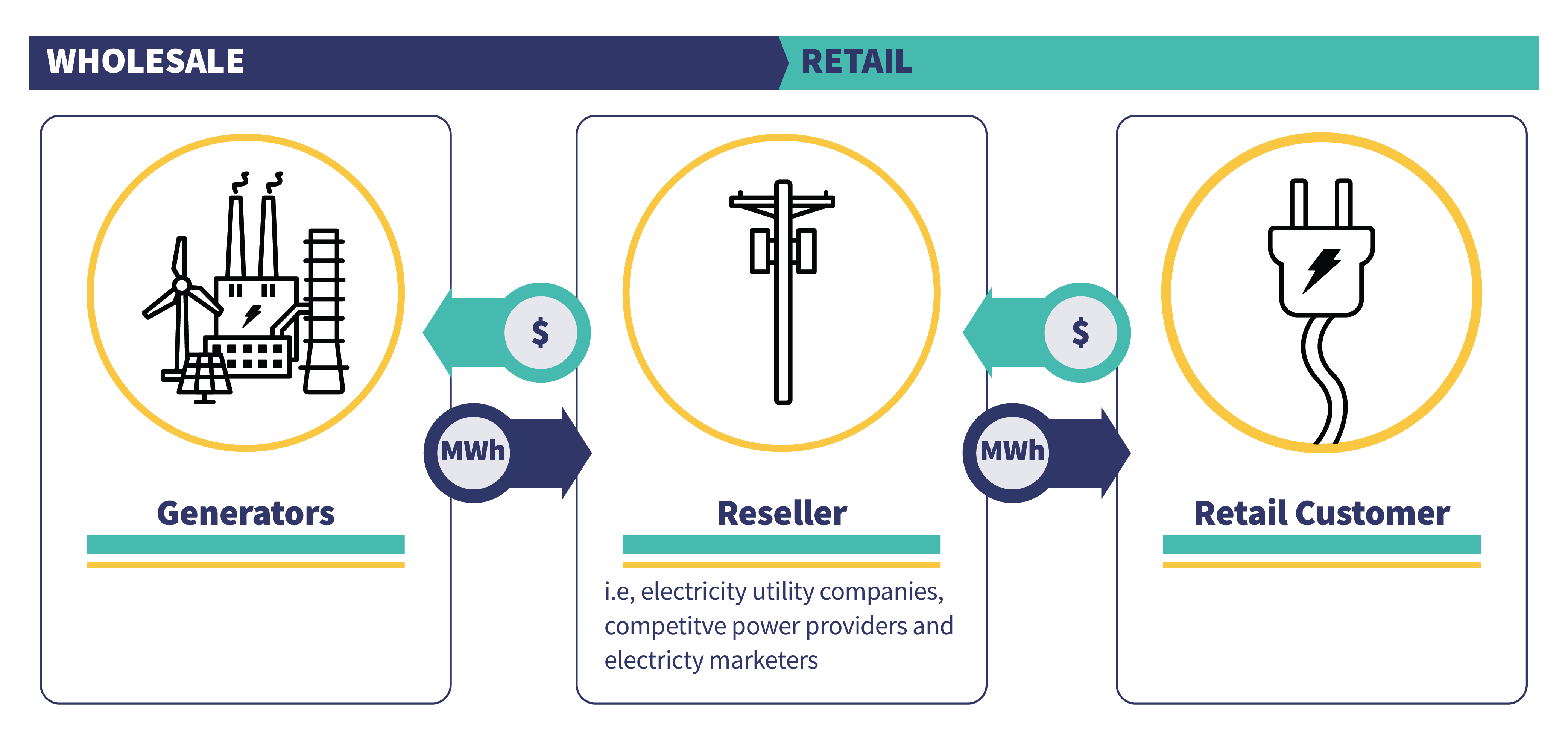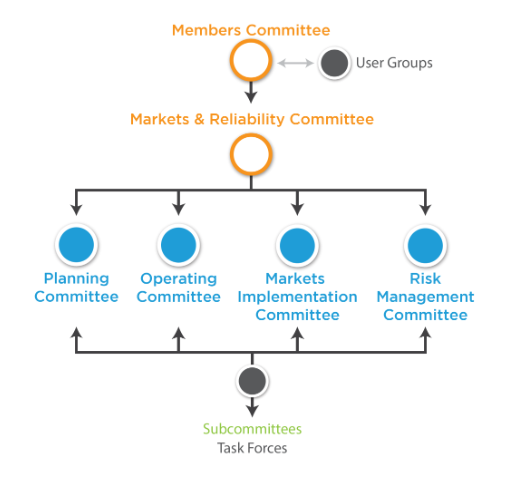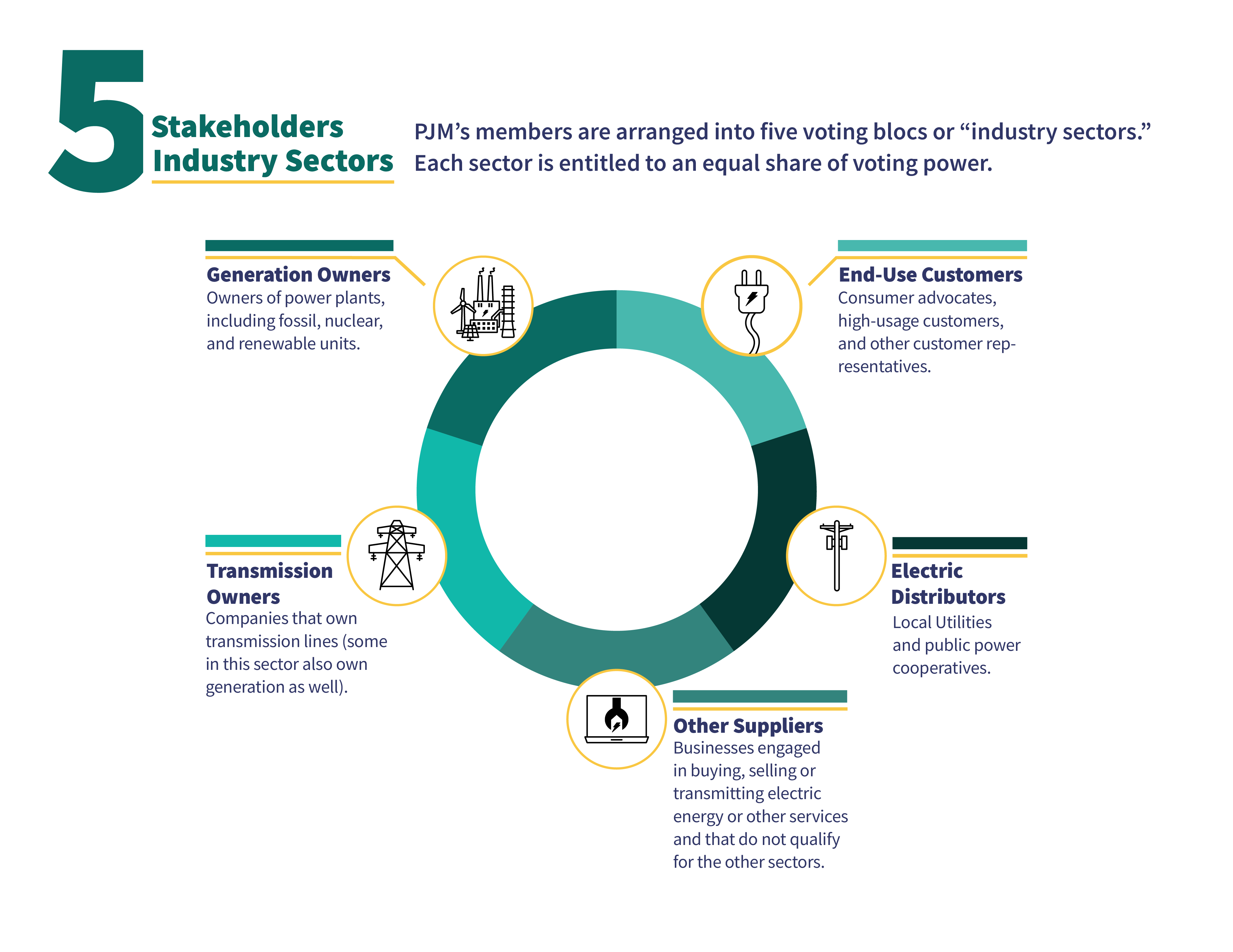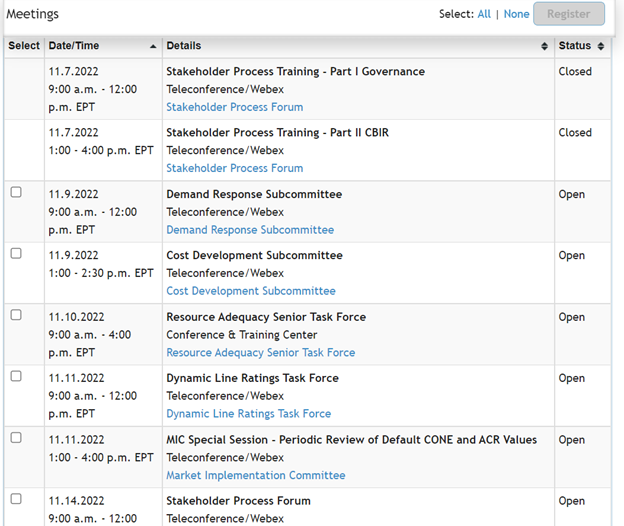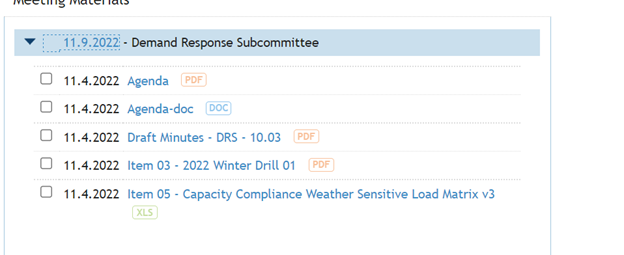Q. What is PJM and what does it do?
A. PJM Interconnection, L.L.C. (PJM) operates the electric transmission system or “grid” for all or part of 13 states and the District of Columbia. PJM is the independent system operator (ISO) and regional transmission organization (RTO) for the area, shaded in blue in the below map, that spans all or part of the states of Pennsylvania, New Jersey, Maryland (indeed, the name “PJM” comes from these three states, who formed the original core), Delaware, Ohio, Michigan, Illinois, Indiana, Virginia, West Virginia, North Carolina, Kentucky, a small part of Tennessee, along with the District of Columbia. Before becoming the nation’s first fully functioning RTO in 2002, PJM operated for decades as a “power pool” that allowed for power sharing among participating utilities. PJM is headquartered in Valley Forge, Pennsylvania.
As an RTO, PJM coordinates the flow of electricity across the high-voltage, long-distance electric lines in the PJM region and develops market and reliability rules so that the wholesale electricity transmission system operates reliably and safely. In the absence of such coordination, the flow of electricity could be limited on portions of the electric transmission grid, which is known as “congestion.” Just as vehicle traffic can become congested due to weather or road repair, the electric grid can become congested due to heavy demand during times of system stress (e.g., hot or cold weather) or because a transmission line is down for maintenance. PJM manages the flow of electricity and has a control room to monitor congestion and emergencies on the grid at all times. You can think of this as being somewhat similar to an air traffic controller station at an airport, with PJM system operators maintaining awareness to evolving circumstances or new issues developing on the grid in order to maintain electric flow, reduce congestion, and prevent outages and emergencies.
PJM is one of seven ISOs or RTOs that the Federal Energy Regulatory Commission (FERC) has overseen the development of since the late 1990s. RTO/ISOs are non-profit entities designed to ensure non-discriminatory access to the grid, so that sellers and buyers of wholesale electricity are able to connect with ease and efficiency and achieve competitive, fair, market-based prices reflecting supply and demand. In addition to operating the grid, another key part of PJM’s activities is the day-to-day business of running wholesale electricity markets in its territory, which is an intricate operation that relies on complex market rules. PJM develops these market rules based in part on input from stakeholders (representatives from different groups, such as power suppliers and marketers, consumer organizations, utilities, and others) and rulings by FERC. FERC has regulatory oversight over PJM’s activities.
Q. What does it mean when you refer to the “wholesale electricity transmission system” or the “bulk power system?”
A. PJM, under FERC jurisdiction, operates high-voltage transmission lines that move wholesale power throughout its territory, often across significant distances. By contrast, power lines that deliver electricity to retail customers on utility poles are considered to be local “distribution,” and are generally subject to state or local regulation and jurisdiction.
One key distinction between transmission lines and distribution lines is voltage: in general, local distribution lines are lower voltage – typically 100 kilovolts or less – and high-voltage transmission lines are typically everything above that. PJM operates (and FERC regulates) the high-voltage transmission lines and approves the rates for the power that flows on those lines. These activities are often referred to collectively as the “bulk power system” or “wholesale electric transmission system” in PJM.
The following diagram illustrates how electricity travels, including PJM’s operation of transmission lines subject to FERC’s jurisdiction[i]:
You have probably seen tall poles carrying electricity along a strip of land that look like the tall metallic pole in the middle of the above picture; this is an example of high voltage electricity transmission managed by PJM in its territory.
Q. Does PJM own the electric transmission infrastructure that it operates?
A. No – PJM operates those lines but does not own them. Utilities that choose to join PJM continue to own the transmission infrastructure (lines and poles and other equipment) but hand over operational control to PJM. PJM is called an “independent system operator” or “ISO” because it has independent authority, overseen by FERC, to operate the transmission lines owned by the utilities. PJM has also been designated by FERC as the “regional transmission organization” or “RTO” for its territory.
Utilities that join and turn over functional control of their transmission assets to PJM are referred to as “participating transmission owners.” In return, such utilities receive just and reasonable rates through PJM when those transmission facilities are used, with the payments coming from the users or allocated in accordance with PJM rules.
Q. What does “wholesale electricity” mean, and why does PJM operate a market for it?
A. To understand wholesale sales of electricity, consider the graphic below. In the graphic, the electric generation plant (Generator) sells electricity to a utility or other company that resells electricity (Reseller), who in turn intends to resell that electricity to homes and businesses (Retail Customer). The sale from Generator to Reseller is a wholesale sale of electricity and FERC almost always has jurisdiction over the rates charged for that sale. Wholesale sales in PJM territory are considered interstate commerce because of the interconnected grid across numerous state lines.
Wholesale sales of electricity can be contrasted with “retail” sales of electricity to customers. When your local utility sells you electricity for use in your home or business, that is a retail sale, not wholesale, and is not under the jurisdiction of FERC. In PJM and the other RTO/ISOs, retail electric service is provided to customers by your local utility company. The rates those retail utilities charge are regulated by a state utility regulatory commission (for privately owned utilities), by a city (for municipal utilities), or by a cooperative board (for rural electric cooperatives).
If you have concerns about your retail electric bill or service, the right place to address those concerns is with your utility, the applicable local regulatory authority, or your state public utility commission - not PJM or FERC.
Q. Why are PJM processes and markets important?
A. Although PJM is not directly involved with your electric bill or the electric service to your home or business (as noted above, those tasks are met by your utility), PJM makes decisions that can have a major impact on the price and reliability of electricity in your area as well as on the implementation of key state and federal energy and environmental policies.
For example, it is PJM’s responsibility to balance demand for electricity with the available supply through operation of its wholesale electricity market. Electric grids must run in balance, i.e., the electricity coming onto the grid must equal the electricity being used on the grid at all times. PJM, like all RTOs/ISOs, achieves this essential balancing function through the real-time energy market. In the real-time energy market, energy is procured from electricity sellers by PJM for immediate delivery, with prices calculated at five-minute intervals based on actual system operating conditions.
In addition to the real-time energy market, PJM also manages a day-ahead energy market, certain ancillary services markets to procure special products, and a capacity market to procure electricity supply for longer-term reliability needs. In the day-ahead energy market, prices are calculated for the next day based on the amount of energy that electricity suppliers offer to produce and the amount needed by consumers. For reasons we will discuss below, most electric energy is bought and sold in the day-ahead energy market. For PJM’s capacity market, called the Reliability Pricing Model or “RPM,” electricity supplies are procured three years in advance of the delivery year with a goal of ensuring long-term grid reliability.
- Day-Ahead Energy Market
The day-ahead energy market schedules generators (supply) to meet forecasted load (demand) one day in advance, with forecasts influenced by many factors, especially weather. The day-ahead market consists of a bidding process that utilizes supply and demand fundamentals. PJM uses a computerized market model that matches the supply and demand throughout its footprint for each operating hour of the next day. The day-ahead approach gives power plant owners and other suppliers time to plan, schedule workers and shifts (as large plants need to be started up well in advance of production), and make any necessary fuel arrangements. The majority of energy transactions take place in the day-ahead market rather than the real-time market.
The day-ahead market further allows PJM to manage transmission congestion that may arise from prevailing conditions. Transmission congestion occurs when a portion of the transmission grid becomes overloaded with electric energy which can prevent efficient market transactions from taking place. Such overloading can cause a transmission line to retain heat, stretch and, in an extreme case, come in physical contact with other transmission lines, structures, or vegetation, which can create a hazard or outage. To avoid this, PJM uses a security-constrained economic dispatch (SCED) model, which chooses the lowest-cost resources, while taking into account congestion costs. This might mean that a power plant or other supply resource located close to a demand center (for example, a large town or city) could be scheduled to produce electricity on a certain day even if it is not the lowest-cost resource. - Real-Time Energy Market
Through the real-time energy market, PJM reconciles differences between forecasted and real-time load (demand), or other unforeseen system conditions, which may arise from issues such as unplanned outages of power plants, unexpected levels of congestion on electric transmission lines, or increased demand for electricity due to more extreme weather than forecast. Where there is a shortfall of electric supply in real-time, PJM procures electricity for immediate delivery from electricity suppliers that are synchronized to the electric grid and can increase their supply (or, for a demand response resource, reduce demand). The lowest-cost supply bids that can meet the updated demand will be selected first to help ensure that prices remain as low as possible. PJM, with the help of computer software, monitors and re-evaluates the supply/demand balance for electric energy around the clock to be prepared to add resources in real-time when needed for reliability. - Ancillary Services Markets
PJM has other specialized products and services that it procures to control the critical balance of supply and demand on the grid. Through its “ancillary services” markets, PJM seeks to ensure that there are adequate electric reserves to maintain reliability and sufficient voltage to enable the grid to operate. PJM has several ancillary service markets for different types of energy reserves and one for voltage regulation. Ancillary services markets can help PJM meet the reliability standards set by the North American Electric Reliability Corporation,[ii] which issues such standards subject to FERC oversight. - PJM Capacity Market (RPM)
Unlike the day-ahead and real-time energy markets, which are concerned with meeting the near-term demand for electricity, PJM’s capacity market, RPM, is a planning tool that encourages financial investment in existing or new power plants and other power supply resources to promote reliability over a longer term. PJM produces a load forecast, an estimate of peak demand and how much electricity it will need to meet reliability requirements in each area of the system three years in advance of the delivery year. The capacity market consists of a bidding process that utilizes supply and demand fundamentals to compensate existing or new resources. The process for selecting resources in advance of the delivery year for participation in the RPM is called the “Base Residual Auction,” and it is supplemented as necessary by incremental auctions as the delivery year approaches. PJM then pays generators that are selected through the auctions the appropriate capacity revenues, based on their location in the PJM footprint, in return for the future promise of delivering electricity when needed. The revenue received from capacity markets allows power supply resources to cover costs that are generally not covered in the energy markets, such as long-term fixed costs. There can also be penalties if a power plant or other power supply resource fails to meet its advance commitment to supply electricity when needed, particularly during system emergencies.
Q. How is PJM governed and what is the stakeholder process?
A. PJM has an executive team and is overseen by an independent Board of Managers (Board) consisting of ten members. Nine members are elected and the PJM CEO serves as the tenth member by virtue of the office. Each member serves a three-year term, and the ends of the terms are staggered to ensure continuity on the Board. There are some qualification requirements for the experience levels of Board members so that the Board will have the required expertise in the fields of utilities, finance, regulation, engineering, and markets. Information about the current members of the Board (including the PJM CEO) may be found on the PJM website.[iii]
Stakeholders also play an important role in PJM’s operations. This is because stakeholder voting and participation are primary ways that PJM’s market rules are developed and revised. There are many regular stakeholder meetings, including an annual meeting of stakeholders, and approximately monthly meetings of the Members Committee and the Markets Implementation Committee. Shown below is a diagram of the stakeholder process and committees from the PJM website.[iv]
A key PJM Committee is the Members Committee, shown at the top of the above diagram, which is composed of representatives of all the PJM Members. The Members Committee reports directly to the PJM Board. Another key Committee is the Markets and Reliability Committee, which takes input from several other committees on issues related to the markets, electric reliability, system planning and similar matters (see the blue boxes above). The Members Committee and the Markets and Reliability Committee are considered “Senior Standing Committees.”
For purposes of voting in the Senior Standing Committees, the PJM Members are divided into five sectors: Generation Owners, Other Suppliers, Transmission Owners, Electric Distributors, and End-Use Customers, and a process called “sector-weighted voting” is used (see diagram below). In sector-weighted voting, each of the five sectors contributes to 20% of the overall vote. To understand why this is necessary using a simplified example, consider a meeting where 30 end-use customer sector members are present to vote while the other four sectors only have 6 members each present. In this scenario, if a simple one-person/one-vote scheme were used, the end use customers, if unified, could dominate the voting, with 30 votes compared to a combined 24 from the other four sectors. By contrast, under sector-weighted voting, the 30 end users would determine only the 20% share of the vote from the end user sector, and the 6 voting members in each of the other sectors would determine the stance for each of their 20% shares.
Each state in PJM has at least one separate state agency, unit within a state agency, or a state-designated non-profit organization that represents consumer interests, referred to herein as “state consumer advocate offices.” Representatives of such state consumer advocate offices (limited to one per state plus D.C.) may vote in the end-use customer sector. FERC, State utility commissions, and other regulatory authorities do not have voting representatives but may nominate one non-voting member to each of the Standing Committees.
Q. What is a PJM Member? What is a PJM Stakeholder?
A. PJM members include traditional electric utilities, transmission and generator owners, organizations that can sell electricity to end-users, marketing firms and end-use customers. PJM members take part in PJM’s stakeholder process, which provides a forum for those who have a stake in the issues relating to PJM markets and operations, public policies and current and future industry matters. There is an application, certain requirements, and a process to become a member, and unless an exception applies, the current annual fee for members is $5,000.
PJM stakeholders include PJM members, certain state officials and advocates, and others. PJM stakeholders have a “seat at the table” to discuss PJM’s operations, markets and reliability, as well as issues concerning the broader electricity industry. Stakeholders who are not PJM members are invited to participate in stakeholder meetings to foster collaboration between members, government organizations, advocates and the general public. However, stakeholders who are not members cannot vote in committee or sub-committee meetings.
Q. How are decisions made at PJM?
A. Any stakeholder, including a non-PJM member, can seek to bring an idea for consideration in the PJM stakeholder process, typically beginning by bringing a problem statement and issue charge to one of the technical committees (shown in the blue circles in the above graphic). If the problem statement is approved, PJM works with stakeholders to develop a workplan to address the issue, including which committee/sub-committee will have oversight, and what the final work product will encompass (i.e., business practice manuals or proposed tariff revisions). PJM will typically develop a solutions package, which are options to address the identified issue(s). Other stakeholders can offer their own solutions to the problem statement. If the final solution to the problem statement has sufficient support, it would advance to the Markets and Reliability Committee and ultimately to the Members Committee. Each of those two committees requires a supermajority 2/3 vote to pass. Members can vote in favor of a solution, against a solution, or abstain.
Ultimately, the PJM Board can determine whether the issue that has arisen through the Committee process will get filed with FERC as a proposed change to the market rules or reliability rules governing PJM. PJM Board rulings are generally made by a majority vote of those present at the Board meeting. The Members Committee can also determine, upon a two-thirds supermajority committee vote, to file with FERC for change in any provision of a tariff, pursuant to section 205 of the Federal Power Act, even without PJM Board approval.
In addition to the above description of filing rights under Section 205 of the Federal Power Act, any individual or group also has the ability, without committee or PJM Board approval, to file with FERC under Section 206 of such Act to claim that a PJM market rule is unjust and unreasonable.
Q. What is the Organization of PJM States (OPSI) and what is its role?
A. The public utility commissions in each state in PJM’s footprint represent a special type of non-voting stakeholder. Each such commission is a member of the Organization of PJM States, Inc. (OPSI). OPSI represents the interests of the utility regulatory agencies in the 14 state (and DC) jurisdictions that are part of PJM, as shown in the above map.[v] Among other things, OPSI coordinates the analysis of issues and data and formulates policy related to PJM issues for the state and DC utility commissions. While being members of OPSI, each state commission also retains its rights and roles as statutory regulators. According to PJM, OPSI “plays an important role in fostering a cooperative regional approach among the states on PJM issues and in advising PJM on regulators’ concerns and viewpoints.”[vi]
Q. What is the organization called “Consumer Advocates of the PJM States”?
A. The Consumer Advocates of the PJM States, often referred to as “CAPS,” represents the interests of the state consumer advocate offices in PJM, who are voting members and stakeholders in PJM. There are 16 CAPS members in the 14 jurisdictions (13 states plus DC), as two states (North Carolina and Illinois) have two different agencies that are CAPS members.[vii] The stated goals of CAPS are to “establish[] reliability throughout the region at the most cost-effective prices,” “use resources to provide awareness and… contribut[e] to the stakeholder process,” and “expand dialogue with both demand and supply interests [at PJM] to seek consensus.”[viii] CAPS is unique in that it is the only such multi-state consumer organization in an RTO/ISO that is funded through a tariff mechanism as authorized by FERC.
Q. Does PJM have other stakeholder groups?
A. Yes. PJM has other user groups, sometimes comprised of or including non-voting stakeholders, that engage with PJM on issues of governance and operations. An example is the Public Interest & Environmental Organizations User Group (PIEOUG), which consists of public interest, environmental, and consumer advocate organizations. PIEOUG convenes regularly to discuss issues being addressed by PJM’s committees and engages with the PJM Board about their perspectives. The PIEOUG Charter states, among other things, that its purpose is to “provide access to the PJM stakeholder process for organizations not eligible for membership [and] provide a venue for PJM staff to educate and solicit input from the environmental and public interest community.”[ix]
Q. How can people interested in PJM issues participate and attend public meetings?
A. PJM stakeholder meetings are open to the public and members of the media unless otherwise noted, although members of the media are asked to announce their presence and they cannot quote a speaker without permission. Remote participation at meetings is often available by telephone or WebEx. There are typically opportunities to ask questions, including by non-members.
PJM has an area on their website called the “Meeting Center” where one can find notice about meetings and training, including any that require pre-registration.[x]
Here is a sample of the information and the links you can find in the Meeting Center:
As you can see toward the top right of the above picture, there is also a convenient button that would allow one to register for a selected meeting.
To give you a sense of the type of information available on-line for a meeting, here is what happens when you click on the blue link above to the “Demand Response Subcommittee” meeting:
There is ample information about the agenda and specific agenda items. Information about prior recent meetings is also available so you can learn about the history of a particular issue or committee/subcommittee activity. PJM also has a handy issue tracking link on its website where one may do a search to obtain updates on an issue of interest.[xi]
Q. How can a person that is interested in PJM matters impact PJM decision-making processes?
A. As discussed above, PJM committee meetings provide opportunities for the public to attend and ask questions, although voting is restricted to PJM members. Any individual wishing to raise an issue in PJM may do so by seeking to add an item to the agenda of a Committee meeting, but there would be an approval process by Committee leadership.
As with all RTOs/ISOs, the issues before the PJM Board and stakeholder committees are often quite complex and detailed, written in technical or legal language, and in some cases reflect the development of over twenty years of history and negotiation. Thus, there may be value in trying to coordinate your efforts with organizations or individuals who share your perspectives and have familiarity with PJM processes. Whatever your interests are, you are very likely to find that there are like-minded stakeholders that are already participating actively and would appreciate your input and support, whether your issue is rates, environmental questions, reliability, or something else. Even experienced PJM stakeholders often try to build coalitions to accomplish goals through the committee process and at the PJM Board level rather than trying to “go it alone.”
You can also seek to connect with your state public utility commission[xii] to learn more about its positions in PJM matters. As noted above, if you reside in the PJM footprint, your state commission is already a member of OPSI and has a key role in PJM committees and processes. You can also reach your state consumer advocate’s office[xiii] to coordinate and learn about its stances on PJM matters, or you may contact the CAPS (Consumer Advocates of the PJM States) organization.[xiv]
Q. How do I learn more about PJM?
A. The PJM website is an excellent place to start. The Meeting Center page on the website can keep you updated and prepared for upcoming meetings that are open to the public. There is also a specific page on the PJM website, tabbed at the top of the home screen, for training, including the dates, locations, target audience, and virtual participation options.[xv] PJM also has a Learning Center on the PJM website, offering interesting modules on electricity basics, the structure and priorities of PJM, energy innovations, and other topics.[xvi]
FERC also has resources that can help you gain more general background on the electric industry, with some specifics on PJM, in its 2020 Energy Primer.[xvii] If you would like more information about PJM, you may also contact the Office of Public Participation (OPP) for information as well as help with navigating FERC’s web resources. OPP may be reached by e-mail at [email protected] or by phone at (202) 502-6595.
[i] Graphic developed by the National Energy Education Development Project, Electricity, at 56 (2017), http://www.need.org/Files/curriculum/infobook/Elec1S.pdf.
[iv] https://www.pjm.com/committees-and-groups/committees/~/media/committees-groups/committee-structure-diagram.ashx
[v] Members include the Delaware Public Service Commission, Public Service Commission of the District of Columbia, Illinois Commerce Commission, Indiana Utility Regulatory Commission, Kentucky Public Service Commission, Maryland Public Service Commission, Michigan Public Service Commission, New Jersey Board of Public Utilities, North Carolina Utilities Commission, Public Utilities Commission of Ohio, Pennsylvania Public Utility Commission, Tennessee Public Utility Commission, Virginia State Corporation Commission, and the Public Service Commission of West Virginia.
[vii] The members of CAPS include the Delaware Office of the Public Advocate, District of Columbia Office of the People’s Counsel, Illinois Citizens Utility Board, Illinois Office of the Attorney General, Indiana Office of the Utility Consumer Counselor, Kentucky Office of Rate Intervention, Maryland Office of the People’s Counsel, Michigan Department of the Attorney General, New Jersey Division of Rate Counsel, North Carolina Office of Attorney General, North Carolina Public Staff (NCUC), Ohio Office of the Consumers’ Counsel, Pennsylvania Office of the Consumer Advocate, Tennessee Office of the Attorney General, Virginia Office of the Attorney General, and West Virginia Consumer Advocate Division.
[viii] https://pjm.com/-/media/committees-groups/user-groups/pieoug/2022/20220518/20220518-caps-pieoug-presentation.ashx
[xii] You can find your state commission here: https://naruc.org/about-naruc/regulatory-commissions/
[xiii] You can find most state consumer advocate offices here: https://www.nasuca.org/members/
[xiv] Greg Poulos, Executive Director, CAPS, 614-507-7377, [email protected]

